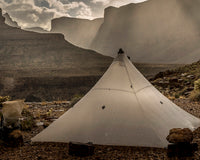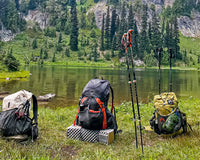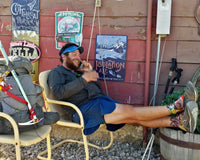Crossing Forester Pass in 2011
We stared up at the jagged peaks, attempting to match them to our topographic map. There were no footprints in the snow. The blanket of white ran all the way up to the portal into King’s Canyon National Park. It was 2011 on the Pacific Crest Trail, and navigating through the Sierra was a constant struggle after a winter of record snowfall. I had learned navigation by map and compass, trial and error. Printed maps were my lifeline and intuition was my skill. It was a true wilderness experience and one of immense learning.
At 20 years old I entered the Sierra Nevada Mountains from Kennedy Meadows with eight other hikers. We were a tight-knit group and saw few other hikers in that section. It was a solitary group working together to traverse an untouched landscape. Our steps were on virgin snow and we had the 12,000 foot passes to ourselves.
2011 was only the beginning of my relationship with the Pacific Crest Trail. I made lifelong friends on my first thru-hike and developed an unconditional love of the trail lifestyle.
Entering the Sierra Nevada in 2011
In the years since, I’ve logged 20,000 more trail miles across the country and witnessed changes both big and small within the long-distance hiking community.
The bestselling book “Wild” was released in 2012, and a movie by the same name debuted in 2014. Whether the exposure, the aging of millennials, or some other reason, the long-distance trails exploded with hikers.
Entire industries were created around the new influx of hikers. GPS apps replaced paper maps, trail magic became more plentiful, and defined campsites developed everywhere. From 2011 to 2016, the number of finishers on the Pacific Crest Trail quintupled. The Appalachian Trail experienced similar growth with the number of hikers more than doubling from 2010 to 2017.
The Good

The John Muir Trail, which is part of the Pacific Crest Trail, in 2019
With the increased popularity, the managing organizations of the long-distance trails received more funding, volunteers, and exposure. From 2011 to 2019 the private donations to the Pacific Crest Trail Association nearly doubled.
Beyond the financials, businesses sprung up around the trails. Cottage backpacking companies appeared and gear drastically improved. Business opportunities bled into press websites and even more exposure for “The Adventure of a Lifetime.” Gear innovations transformed backpacking and halved the average base weight.
Water caches and trail magic are plentiful for today’s hikers. The trail gatherings of PCT Days and Trail Days grow every year. Stories are shared through social media and there is never a better time to be an aspirational hiker.
The Continental Divide Trail has seen the most physical growth. The route has been moved off roads, cross country basins, and 4x4 roads onto constructed trails throughout its length. Once considered solely a route, the Continental Divide Trail Coalition has grown dramatically and has all but 173 miles protected. The volunteer hours alone have grown 400% of where they sat only 7 years ago.

Continental Divide Trail in Colorado 2018
The community around the trails has blossomed into an amazing resource for prospective hikers. Gear lists, resupply guides, and advice are everywhere. More hostels have sprung up to coincide with the long-distance trails around the country. Nationwide movements and sentiment toward protecting public lands have periodically dominated the news cycle. A once niche community has grown to be a real force in the outdoor space.
The Bad
With the exponential increase in thru-hikers, the trails have lost a portion of their personal touch. It is impossible to know every other thru-hiker on a long-distance trail. Trail angels have begun retiring because they can no longer handle the strain on their time and resources. Some hikers expect trail magic, rides to town, and an elevated status among other trail users.
For me, the buzz surrounding a Triple Crown trail full of first-time thru-hikers instills a cautious excitement. I love seeing hikers’ fascination with nature, as they learn how to set up a tent, or experience cowboy camping for the first time. It invokes a sense of nostalgia. But this same welcome nostalgia can also be overcome with a sense of longing for the times the trails were less crowded.

Appalachian Trail in 2016
There’s also now more ‘trace’ of the others who have come before on the long trails. Toilet paper flowers and overflowing trash cans at campgrounds emphasize the increased usage. While it’s always been and continues to be a small percentage of hikers who leave more than footprints on the trails, because the total number of hikers has grown, this problem has compounded.
The trail towns along the way have seen both the good and the bad. Business is up and new establishments that cater to hikers have opened, but the increase happened so fast that the growth is fragile. In 2016 I was asked by a business on the Pacific Crest Trail for the scoop on what types of things to order for thru-hikers. The local businesses want to capitalize and help the influx of seasonal wanderers, but it is a lifestyle they cannot comprehend. The economic boost is real, while the strain on resources is also apparent.
Hiker Heaven in Agua Dulce in 2011
In 2011, 150 hikers finished the PCT. Now, over a thousand hikers complete the trail each year. The queue to get a 2020 PCT Thru-Hiking permit reached 10,000 people in December. The desire to be a part of the trail community has never been higher.
The Same

Mt. Whitney in 2019
The route of the Appalachian Trail and Pacific Crest Trail remains largely the same. There is no fee to hike either (with the exception of the Great Smoky Mountains National Park entry fee on the AT), and many of the traditions have stood the test of time. Hikers still walk across the Bridge of the Gods into Washington and eat a half-gallon of ice cream at Pine Grove Furnace General Store to celebrate the halfway point. Time marches on and some things change while others remain the same.
I returned to the PCT first in 2016, then again in 2018, and most recently in 2019 to hike the John Muir Trail. Instead of paper maps in my pocket, I now simply carry a phone with a GPS app. My base weight is a fraction of where it started and I meet enough new people daily that I cannot possibly remember all their names. We are all hikers. There are more of us, but we still all have the same goal of backpacking on the long trails of America.

















